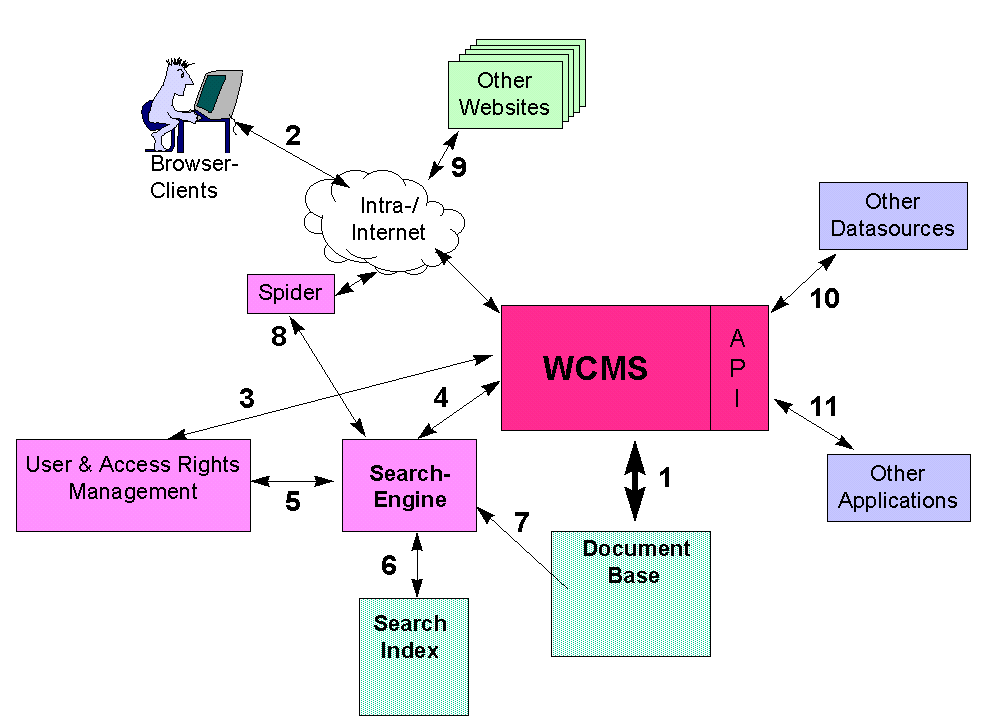| Last modified on 24.03.98 13:26:42 by gst |
Page access count:
|
| Last modified on 24.03.98 13:26:42 by gst |
Page access count:
|

| Name | Description |
| Information Structure | Possibility to structure the information contained in
the system in flexible formats, like trees, graphs. New structure elements
should be create-able on-the-fly.
All information structures should be browsable. |
| Meta Data | It should be possible to define and manage meta data, information about the data beeing stored in the system. Meta data can be viewed as a number of attributes associated with a specific class of objects. |
| Link Management | Hyperlinks maintained automatically, at least between objects in the repository. |
| Separation of Layout
and Content |
Strict separation between the graphical appearance of objects and their content. |
| Browser Client | On the client side only standard browser software |
| Version Management | Ever heard of RCS and CVS? Never start a real project without a version management tool. Nobody should have to live without such versatile systems, something like that must be part of any serious WCM. It should include not only the data objects, but also the meta data (attributes), so that complete versions can be retrieved later. |
| Dynamic assembly of pages | Web pages should be generated "on the fly", on the basis of what is currently needed and what the user is allowed to see. |
| User and Permission Management | It should be possible to assign access/modification permissions to specific users or groups. User authorisation should be integrateble with standard directory services like X500 or LDAP. |
| Search Engine | A powerful, full-text search engine should be integral part of the product. It's good if users can find the required information regardless of document formats. The better search engines can search in over 100 different file formats (office formats, ps, pdf, ...) |
| Extensible | The tool should support custom extensions to better suit specific needs. |
| Graphical Navigation | Explorer or file-manager like navigation |
| Scaleability | Tool can be scaled to fit increasing demand or changing client expectations. That's definitely easier with Unix-based systems (as NT has written children-play-stuff all over). |
| Activity logs | All activites are logged, to be able to track customer downloads (and propably bill them for it!) |
| Integration of existing systems | Integrate existing applications, websites, databases, workflow systems and document management systems into the system. Therefore the WCM needs a high-level API to facilitate such integration efforts. |
A demo version is available from the internet, Hyperwave
provides interested parties with a 30--day evaluation key. Installation
is
simple, accompanied by some fancy (Macromind?) animation.
After I received my licence, everything worked pretty smooth. I even got
some feedback from their support crew within 2-3 days.
Very strong in link management and information structuring via collections. Excellent document versioning, including meta info.
Scalable, runs on a variety of platforms, from Unix to NT. Comes with its own OO-database system, but can store data also in an Oracle database for improved performance.
Version 4.0 is expected to bring server-side JavaScript (see the Netscape library for details...) for more efficient server side programming.
Hyperwave bibliography:
As you can see below, the Hyperwave Information Server
has received quite some attention in print media.
Highly scalable, flexible and powerful. Many excellent
reference projects (Ford, HP, ISO etc).
Due to reasons of privacy and competitive advantage, I
cannot quote all customer names here.
| Deutsches Zentrum für Luft- und Raumfahrt | Implements a blackboard with the Hyperwave WCMS. Simple and straightforward implementation. |
| Kleine Zeitung | An Austrian online newspaper. New layout. The server seems to be "mid-sized" (somewhat slow...) |
| Kinonews | A German cinema newspaper. |
| European Space Agency |